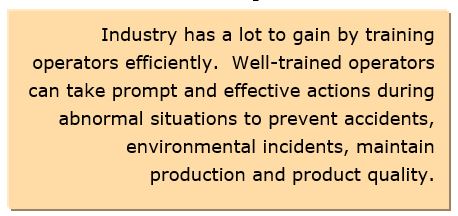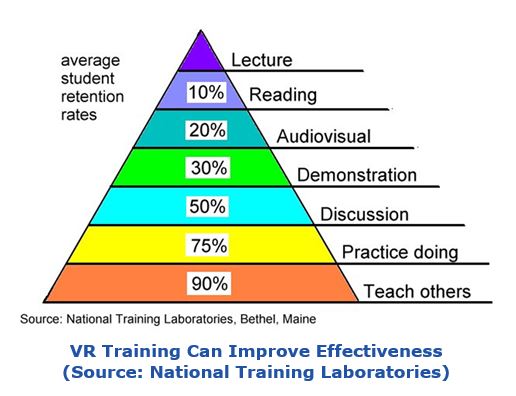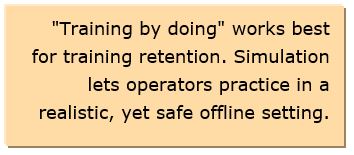

Operators in the process industries control complex industrial equipment and processes, often involving hazardous and/or explosive 
With such a high degree of responsibility, plant owners and managers know how important it is to train operators effectively and efficiently. As with pilots or surgeons, training process operators can be an expensive proposition. The good news is that industry has learned a lot about how to train operators efficiently by utilizing Operator Training Simulation
Models, simulation, and role playing are fundamental to how we learned most of what we know in life. In this Insight, we share how experts from several end user organizations approach the complex human problem of training operators using new modeling and simulation technologies.
It is not often you hear about a company that has spent too much on training its employees or that its employees are more competent than needed. Much more often, we hear about how the lack of training contributed to an accident in which people were injured or equipment damaged. Operator training for industrial processes is a serious business and at the ARC Industry Forum in Orlando, Florida this past February we learned about some comprehensive approaches to operator training by experts in the field.
Both the nuclear and pharmaceutical industries are required by law to provide operator training. In other industries (oil & gas, chemicals, pulp & paper, electric power, discrete manufacturing, etc.) training is not mandated by law, but still important for risk management and business sustainability.
Insurance companies often assess risks based on an organization’s training program and fix their rates accordingly. The direct financial costs due to accidents associated with operator errors can be huge, with expensive lawsuits, environmental cleanup costs, and penalties. A company's reputation can also take a long time to rebuild following a major accident, especially if the investigation points to inadequate operator training or a culture that does not value safety.
Complex and highly automated manufacturing systems give a great deal of responsibility to relatively few operators. Each operator can have 80 to 150 control loops to monitor. Automation can empower operators by regulating tank levels and vessel pressures and many other critical variables. Advanced control applications can help the operators push against the most profitable equipment and product specification constraints to optimize the operation. But operators must know how these control systems function and act quickly if things go wrong. Sometimes small adjustments made early can prevent larger problems.
Often, the typical tranquility in the control room can quickly turn chaotic during startups, shutdowns, or major upsets. Consider an accident like Fukushima where they had a total station blackout and the control system computers went black. Among the lessons learned at Fukushima is that training for field operators needed to be strengthened and it is hard to predict which abnormal situations an operator will face.
All countries have primary and secondary schools in which potential future operators can learn the basics of science, technology, engineering, and mathematics (STEM). Universities graduate students who have mastered advanced curriculums. Different companies and countries differ in the basic educational requirements for process plant operators. Some require only a high school diploma, others require some form of technical schooling. While degrees and diplomas can provide a solid foundation, operators must learn the specific processes and systems they will operate.
Lawrence Staab, training coordinator for Kinder Morgan, is training operators for ten new, large, Shell-designed, liquefaction units being constructed at the Elba Island LNG Terminal, in Savannah, Georgia. Faced with the challenge of training staff quickly, effectively, and efficiently, Mr. Staab outlined the company’s ten-step training program for all plant staff, including maintenance and operations:
This training program is designed to achieve proficiency signoff in nine months, compared to a more traditional peer training method that would take 18 months. The use of simulation- based training as part of this training program is the key, reducing both training time and costs. With the OTS system, operators can practice abnormal situations that cannot be practiced with on-the-job peer training. Simulation allows "training by doing," which has much better retention rates than classroom training. The benefits of using a high-fidelity simulator extend past operator training and include:
Brent A. Kedzierski is the manager of the simulation-based learning project at Shell Oil, which has 23 refineries worldwide. Mr. Kedzierski is tasked with auditing the company's current methods and developing ways to do better. Shell has used simulation for more than ten years, but not all plant locations use it the same way. Mr. Kedzierski explained that the top 25 percent of the company’s generic process simulators had about 85 percent utilization, and twelve of the company’s 33 unit-specific simulators are considered non-functional. That is about normal for industry, since unit-specific simulators require maintenance to keep up with process and control system modifications.
Recognizing that simulation-based training in the refining industry is not as mature as in the nuclear and aviation industries, Shell wanted an improvement strategy that would give the company a competitive edge. In aviation, it would be unthinkable to train pilots without a simulator. The nuclear industry often builds full-scale mock ups of the entire control room and trains all control system personnel as a group in this realistic environment, complete with detailed process simulations. Nuclear simulation codes include full nucleonics for training on situations like a core meltdown.
Operator training was one of five continuous improvement initiatives within Shell. Some of these initiatives were evaluated to have more favorable return on investments, but operator training was among the lowest-cost improvements with a favorable ROI. While it is quite difficult to compute the influence of operator training on the low frequency of potentially costly accidents like environmental releases, fires, or explosions; using simulation-based training with high fidelity dynamic simulation models for the most hazardous processes clearly reduces risk.
Simulation-based training in which the control system or an execution engine for the control system emulation is linked to a dynamic model of the process is well established in the process industry.
Now, we’re also seeing increased use of simulating the spatial geometry of a process plant or a manufacturing plant to provide virtual or augmented reality training for field operators. There has been much technological progress in modeling objects in 3D space driven by camera development, and video gaming technology.
David Lafferty, ARC Associate and President of Scientific Technical Services, updated us on some recent trends in the use of virtual 
Mr. Lafferty reinforced the value that training by "practice doing" is much more effective than relatively boring classroom training. Humans retain training using simulation better, and the new millennial generation is well prepared for this technology.
Industrial training methods are using new web-based training systems, and entrenched conventional classroom training methods are now competing with new immersive methods often using software and hardware developed for the gaming industry.
Several significant trends are helping drive increased acceptance in virtual and augmented reality for training purposes:
A key theme that came through at the OTS session at the ARC Industry Forum was that "training by doing" is the most effective way 
Training field operators with immersive 3D visualization is gaining traction across the process industries. The technology developments in 3D modeling of field equipment along with AR and VR technologies will change the landscape for field operator training. The new Millennial generation of operators are well equipped to use these training methods.
If you would like to buy this report or obtain information about how to become a client, please Contact Us
Keywords: Operator Training Simulator (OTS), Immersive Training, Virtual Reality (VR), Augmented Reality (AR), ARC Advisory Group.

